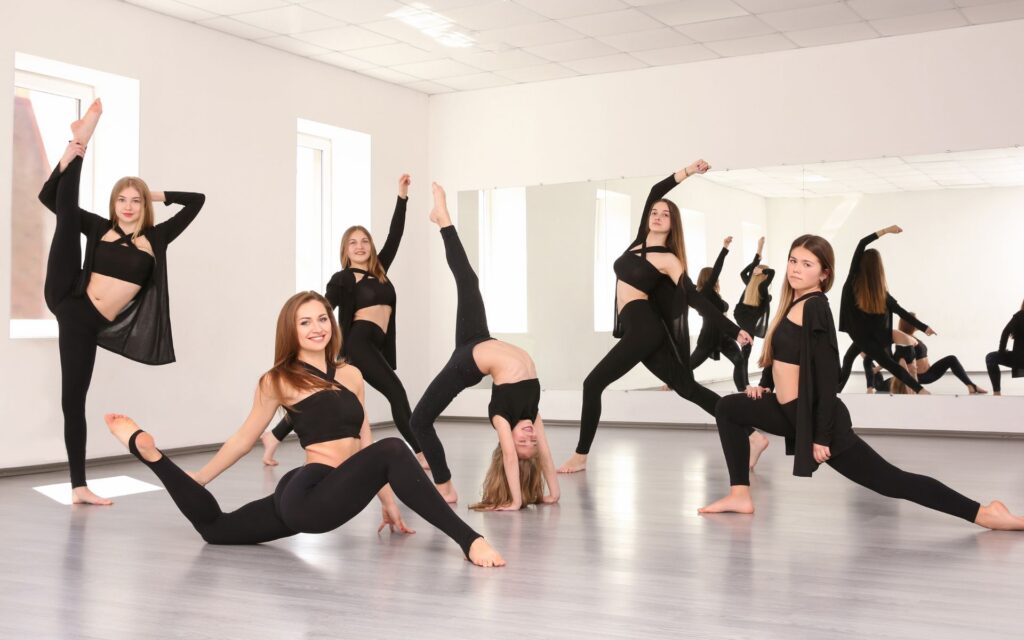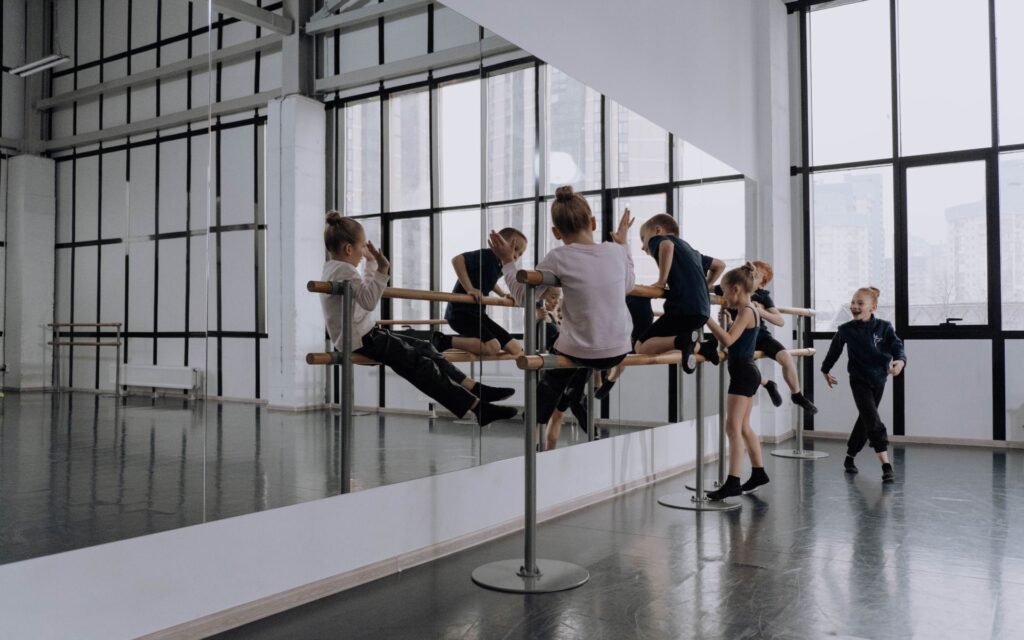Have you ever dreamed of entering the business world by opening a dance studio? From the infectious energy of hip-hop to the graceful flow of ballet, a dance studio can be a vibrant center of creativity, expression and community. Opening a dance studio in 2024 is an exciting venture that combines passion with entrepreneurship.
This step-by-step guide will be your personal rhythm section, guiding you through the basic elements of opening a successful dance studio in 2024. Whether you dream of teaching ballet, hip-hop, salsa or contemporary dance, starting your own studio offers a unique opportunity to shape the next generation of dancers and create a thriving business centered around the art of movement.
We’ll discuss everything from securing permits and finding the perfect location, to choosing the right dance styles and creating a welcoming environment. Plus, we’ll explore how modern fitness studio management software can help you keep your business running at the perfect time.
Additionally, we’ll discuss the role of dance studio software – a key tool that simplifies scheduling, registration, invoicing and communication with clients, streamlining operations so you can focus more on dancing and less on paperwork.
So, lace up your dancing shoes and get ready to turn your passion into a thriving enterprise!

How to open your own dance studio?
Opening a dance studio in 2024 is a fantastic opportunity for those who want to become owners of their own dance space. It’s also an excellent business idea for entrepreneurs passionate about dance and the performing arts.
A dance studio is a dedicated space where instructors lead classes that teach various dance styles, such as hip hop, ballet, jazz, and contemporary. If you are wondering how to open a dance studio or how to start your own dance studio, you are embarking on a journey that not only promotes physical fitness and creativity but also offers a significant business opportunity.

This venture requires thoughtful planning, from understanding the basics of dance instruction to mastering the intricacies of business management. Whether you are a seasoned dance enthusiast or a newcomer looking to dive into the dance industry, this guide will provide you with the necessary steps to create a thriving dance studio that meets the needs of your community.
How to start a dance studio?
Remember about those 4 main points!
- Distinctive Atmosphere: Lorem ipsum dolor sit amet, consectetur adipiscing elit, sed do eiusmod tempor incididunt ut labore et dolore magna aliqua
- Diverse Class Offerings: Lorem ipsum dolor sit amet, consectetur adipiscing elit, sed do eiusmod tempor incididunt ut labore et dolore magna aliqua
- Community Engagement: Lorem ipsum dolor sit amet, consectetur adipiscing elit, sed do eiusmod tempor incididunt ut labore et dolore magna aliqua
- Holistic Services: Lorem ipsum dolor sit amet, consectetur adipiscing elit, sed do eiusmod tempor incididunt ut labore et dolore magna aliqua
Step 1: Create a business plan for your thriving dance studio
A comprehensive dance studio business plan is crucial for the success of your studio. This plan should outline your vision, mission, target market, competition analysis, marketing strategies, and financial projections. Consider what makes your dance studio unique and how you can attract and retain students.

Highlight the types of dance lessons you will offer, such as:
- hip hop dance classes,
- ballet,
- jazz,
- ballroom dance,
- acro dance,
- folk dances,
- street dance
- contemporary.
Good to know!
Which dance studio is the most popular choice for customers? Most preferably one with well-trained instructors who are certified. What also matters is the style of exercise, which can vary, the atmosphere of the place, but also the location.
Step 2: Think of dance studio business structure
As you plan to open a dance studio, it’s crucial to decide on the appropriate business structure. This decision will impact your studio’s:
- company responsibility,
- taxes and any associated fees,
- management style of the studio.
Typical business structures for a dance studio include:
- Sole proprietorship – this structure is simple and easy to set up, making it ideal for a studio with a single owner and minimal risk exposure. It’s a straightforward option for those starting small.
- Partnership – this is suitable if you are co-founding the dance studio with another person and are ready to share decisions and responsibilities. Partnerships allow for shared resources and collaborative management.
- Limited liability company (LLC) – often the preferred choice, an LLC offers liability protection by separating personal assets from business debts. It also provides flexibility in tax handling and is suitable for studios of various sizes looking for a balance of simplicity and protection.
- Corporation, or possibly a franchise partnership – for larger studios anticipating significant growth or investment, incorporating may be beneficial. This structure offers strong liability protection and options for raising capital. It is ideal for studios with plans for substantial expansion.

Each business structure has its unique advantages and requirements. It’s advisable to consult with a business advisor to determine the best fit for your dance studio’s goals and scale, ensuring you are well-prepared to thrive in the competitive dance industry.
Step 3: Find niche for your new dance industry
Choose dance styles that you or your instructors are passionate about and highly skilled in. Being genuinely enthusiastic and knowledgeable about the dance styles you offer can create a more authentic and engaging experience for students.
By offering a diverse range of dance instructions, your studio can cater to a wide audience and create a vibrant, inclusive community. Each dance style brings its own unique benefits and can attract different types of students, from those seeking to improve their technical skills to those looking for a fun and creative outlet.
Good to know!
Potential niche dance styles that you may consider:
- Barre: A niche blending ballet technique with modern fitness, appealing to adults seeking a challenging, yet graceful workout.
- Wheelchair Dance: Offering inclusive dance classes can address an underserved market and emphasize community and accessibility.
- K-pop Dance: Capitalizing on the global popularity of K-pop, offering classes focusing on learning choreography from popular K-pop music videos.
- Yoga Dance: A fusion of yoga and dance that offers a spiritual and physical workout, attractive to both yoga and dance enthusiasts.
- Dance Therapy: Specializing in dance movement therapy could cater to a market interested in dance as a medium for emotional and physical healing.

Look at the age, cultural background, and fitness levels of people in your area to determine which dance styles might be most appealing. Some dance styles have enduring popularity, ensuring a steady interest over time (e.g., ballet, salsa). Trendy or niche styles (like K-pop or street jazz) might attract initial interest and set your studio apart in a crowded market.
What type of dance styles will you specialize in?
When determining which dance styles to specialize in at your own dance studio, it’s essential to consider a mix that caters to diverse interests and provides unique value. Here are brief characteristics of each type of [dance studio styles]:
- Ballet – classical and disciplined, suitable for all ages; provides a strong foundation in dance technique.
- Hip-Hop – energetic and expressive, popular with younger dancers; includes substyles like breaking and popping.
- Contemporary dance – combines elements of modern, jazz, and ballet; focuses on emotional expression through fluid movements.
- Jazz – upbeat and dynamic, often set to popular music; emphasizes performance and technical skills.
- Tap – rhythmic and musical, challenging dancers to use their feet like drums; enhances musicality and timing.
- Ballroom – elegant and stylish, involves partner dancing; includes Latin styles like salsa and tango, and standard styles like waltz and foxtrot.
- Modern – experimental and creative, often seen as a rebellion against the strictures of ballet; focuses on the dancer’s interpretation and the use of gravity.
- Folk – traditional dances that reflect cultural heritage; includes styles like Flamenco, Irish dance, or African dance.
- Pole Dancing – combines dance and acrobatics centered around a vertical pole; emphasizes strength and flexibility and can be pursued as an art form or a fitness routine.
- Aerial Dance – incorporates apparatuses like silks or hoops suspended from the ceiling; blends acrobatics with dance to create visually stunning performances in the air.
Step 4: Make a market research and find your target
Effective marketing is crucial to attract students to your dance studio. Utilize social media, create a professional website, invest in gym membership management software and offer promotions or free trial classes to generate interest. Network with local schools, community centers, and other organizations to spread the word about your studio. Highlight any special programs or classes, such as hip hop dance classes, to attract a diverse student base.

Step 5: Obtain dance business certification to become part of local market
Ensure you have all the necessary permits and licenses to operate your dance studio legally. This may include a business license, health and safety permits, and any other local requirements. It’s essential to comply with zoning regulations and ensure your studio space meets safety standards.

What licenses are needed to start a dance studio?
Securing music licensing is crucial to legally play music during classes. Dance studio owners must also apply for a business tax ID number, which is necessary for handling business taxes efficiently. Opening a business bank account helps in managing finances, while applying for a small business loan can provide the necessary capital for initial setup, including purchasing a sound system and installing a security system.
Ensuring compliance with all certification requirements not only legitimizes the dance studio but also fosters trust within the community, ultimately contributing to the studio’s success.
Opening a dance studio requirements
Obtaining a dance business certification is essential for dance studio owners looking to establish a solid foundation in the local market. This process involves meeting specific requirements, such as providing a detailed company description that outlines the dance styles offered, class schedules, and target demographics.
Step 6: Set up your new dance studio and find best own space
The location of your dance studio is vital. Look for a space that is easily accessible, has ample parking, and is located in a community with a demand for dance classes. The studio space should be large enough to accommodate dance activities, with high ceilings, proper flooring, mirrors, and a sound system.

Set up your new dance studio by finding the best space in a central location within your local community. Ensure all the details, like a welcoming waiting room, are covered. As a small business owner, choose a spot that attracts and serves your community effectively.
Step 7: Create a place with the best pricing structure
When setting prices for dance classes, studio owners must consider their costs, the competitive landscape, and the perceived value of their offerings. Understanding these factors will help them craft a pricing strategy that attracts students while sustaining their business.
The cost of dance lessons can vary widely based on several key factors such as:
- location,
- type of dance style classes,
- instructor’s experience and reputation,
- class size,
- length of session,
- facilities and amenities.

Some styles, such as ballet or ballroom, may require more specialized instruction and can be priced higher than more common styles like hip-hop or contemporary dance. Highly qualified or renowned instructors often charge more due to their expertise and demand. For example, a session taught by a well-known professional might cost upwards of $50, while a less experienced teacher might charge around $20.
Good to know!
Studios in urban areas or regions with higher living costs typically charge more. For instance, a dance class in New York City might cost between $25 to $40 per session, whereas in a smaller town, the same class might cost $10 to $15.
Many studios offer a single-class rate, e.g., $15 for a one-hour group class. Some studios require a monthly membership that includes a set number of classes per month, e.g., $100 per month for up to 8 classes. Purchasing a package of classes often reduces the cost per class, e.g., buying a package of 10 classes for $120 ($12 per class) versus the standard $15 drop-in rate.
Step 8: Buy or hire dance equipment for your own space
Designing your dance studio space is one of the most exciting parts of the process. Ensure the studio has proper flooring, such as sprung floors, to prevent injuries. Install mirrors (read more about gym mirror ideas), ballet barres, and a high-quality sound system. Create a welcoming reception area and comfortable waiting spaces for parents or guardians of younger students.

Step 9: Develop a profitable studio with low start up costs
Establishing a unique and compelling brand identity is crucial for standing out in the local community. Your brand should reflect the values and mission of your studio, whether it’s inclusivity, creativity, or professional excellence. According to a survey by Nielsen, 59% of consumers prefer to buy new products from brands familiar to them, underscoring the importance of strong branding.
Effective financial planning is essential for maintaining low startup costs and ensuring profitability. Accept credit card payments to provide convenience for your clients and streamline your financial processes. Additionally, consider private funding options, such as loans or investments from friends and family, to cover initial expenses. Keep a close eye on your finances to ensure your income covers your costs.

Calculate how many students you need to achieve profitability. This involves understanding your fixed and variable costs, such as rent, utilities, instructor salaries, and marketing expenses. Setting realistic enrollment targets based on these calculations can help you focus your marketing and outreach efforts effectively. For example, if your monthly expenses are $5,000 and you charge $100 per student, you’ll need at least 50 students to break even.
Step 10: Use dance studio software
Feeling overwhelmed by paperwork and daily tasks? There’s a better way! A dance studio software can simplify your business, free up your time, and keep your members happy. This powerful gym automation system is a game-changer, saving you money and effort

Streamline your operations and boost member satisfaction with effortless organization. Professional systems take care of administrative burdens so you can focus on what you do best: creating a thriving fitness community. Let WodGuru handle the rest, from member sign-ups to account management.

Stop struggling and grow your dance studios with WodGuru! Imagine enjoying the fun side of running dance lessons! Great sports facility management software like WodGuru automates tasks you might not even realize are taking up your time. Delegate those repetitive chores and focus on what truly matters – making your business flourish!
What are the main benefits for using dance studio management software?
- Managing the schedule and book classes: Optimize class schedules by making it easy for customers to book seats online and minimize the risk of overcrowding.
- Flexible settlement and payment processing: Enable customers to make flexible online payments, subscriptions, or class packages, enhancing the studio experience.
- Communication with customers: Keep in touch with customers through notifications of upcoming classes, promotions, or schedule changes.
- Data analysis and reporting: Receive clear reports on class participation, sales, or customer preferences for better planning and business decisions.
Step 11: Recruit the best staff members to raise money
Hiring the best dance instructors is crucial for the success of your dance studio. Quality instructors attract new students and enhance your studio’s reputation, making it a key element of your business plan.
Hire qualified, experienced instructors who are passionate about teaching dance. They should be capable of teaching a variety of dance styles and able to connect with students of all ages and skill levels.

Exceptional dance instructors ensure high-quality classes, which lead to better student retention and satisfaction. Moreover, they play a vital role in your marketing strategy, as word-of-mouth recommendations from satisfied students can significantly boost enrollment. Ultimately, having top-notch dance instructors sets your studio apart and creates a thriving, reputable business that can grow and succeed.
Step 12: Building a loyal clientele and profitable own business
Creating a sense of community within your dance studio will encourage student retention and foster a positive environment. Organize recitals, workshops, and social events to bring students and their families together. Encourage feedback and continually strive to improve your offerings based on the needs and interests of your students.

Effective marketing is crucial to attract students to your dance studio. Utilize social media, create a professional website, and offer promotions or free trial classes to generate interest. Network with local schools, community centers, and other organizations to spread the word about your studio. Highlight any special programs or classes, such as hip hop dance classes, to attract a diverse student base.
Step 13: Attract potential customers - make grand opening event
Opening a dance studio is a rewarding endeavor that allows you to share your passion for dance while creating a successful business. A grand opening event is a powerful way to attract potential customers and should be a key part of your business plan.
GOOD TO KNOW!
Leverage platforms like Facebook, Instagram, and TikTok to showcase your classes and events. With over 4.48 billion social media users worldwide, effective online marketing can significantly boost your studio’s visibility.

Hosting a vibrant event introduces your dance studio to the local community, showcases your offerings, and generates excitement. Include demonstrations by your instructors, trial classes, and special promotions to entice new students. This event also fits into your marketing strategy, creating buzz and drawing media attention. Ensure it’s on your dance studio checklist to kickstart your studio’s journey with a strong, memorable impression.
How much does it cost to open a dance studio?
The cost to open a dance studio varies widely based on location, size, and amenities. On average, you might need between $10,000 to $50,000 to cover initial expenses. Key costs include leasing or purchasing space, renovations, dance flooring, mirrors, sound systems, and furniture.

Additional expenses include licensing, gym insurance, gym marketing software, and initial instructor salaries. Creating a detailed budget as part of your business plan will help you understand how much does it cost to open a dance studio and ensure you cover all necessary costs for a successful launch.
Key Takeaways
- Develop a detailed dance studio business plan. Outline your vision, mission, target market, and financial projections.
- Find a central, accessible space that fits the needs of your local community.
- Ensure your studio complies with local regulations and legal requirements.
- Use dance studio management software. Streamline operations with systems like WodGuru to handle administrative tasks efficiently.
- Utilize online marketing tools, social media, and local promotions to attract new students.
- Provide diverse dance instructions such as hip hop, ballet, jazz, and contemporary to appeal to a broad audience.
- Open a business bank account, apply for a business tax ID number, and consider private funding options.
FAQ
No, you do not need a degree to open a dance studio. However, having experience in dance and business management is beneficial.
How to become a dance teacher at a studio? Think of professional dance training, teaching experience, and relevant certifications that can enhance your credibility and attract students. Focusing on your skills, reputation, and a strong business plan is key to successfully starting and running a dance studio.
A dance studio is considered a service-based business. It provides educational and recreational services by offering dance classes and training to individuals of various ages and skill levels. The studio operates within the fitness and performing arts industry, focusing on physical activity, artistic expression, and community engagement.
Starting a dance studio with no money involves creative strategies and leveraging community resources. Begin by clearly defining your mission statement and business entity. Engage in community outreach to find potential partners or sponsors.
Consider offering classes in community centers or schools to minimize initial costs. Look for grants or small business loans and utilize online platforms for marketing to attract students and build your reputation.
You think of how much do dance studio owners make? Annually varies widely based on factors like location, studio size, and business model. On average, dance studio owners can earn between $20,000 to $100,000 per year. Successful studios with a large number of students and well-managed expenses can see higher profits.
Several dance studios around the world are renowned for their exceptional training, facilities, and notable alumni. Here are some of the best in the US.
The best one is Broadway Dance Center located in New York. This iconic studio is at the heart of the dance world and has trained top dancers like Britney Spears and Madonna. It offers a wide range of programs suitable for all levels of dancers.
Also amazing is Juilliard’s Dance Division – one of the most prestigious in the world, offering rigorous training in various dance styles and producing numerous renowned alumni in the dance industry.





